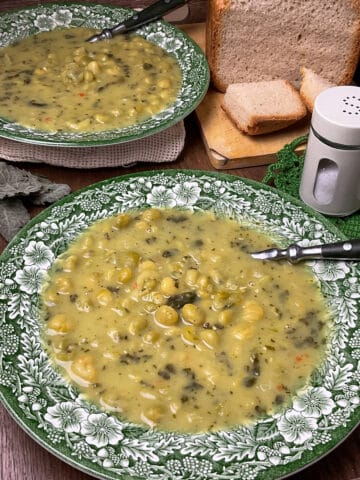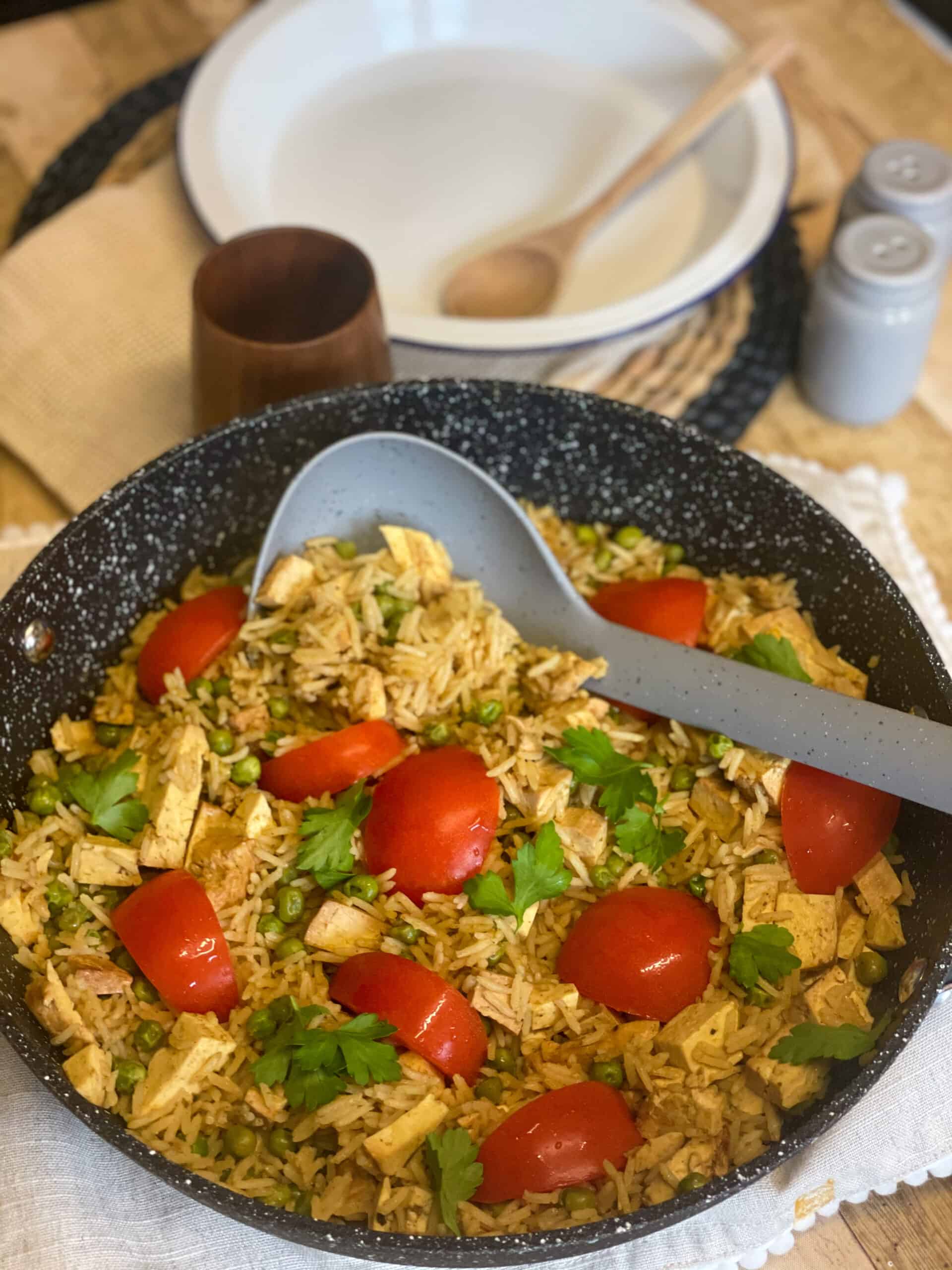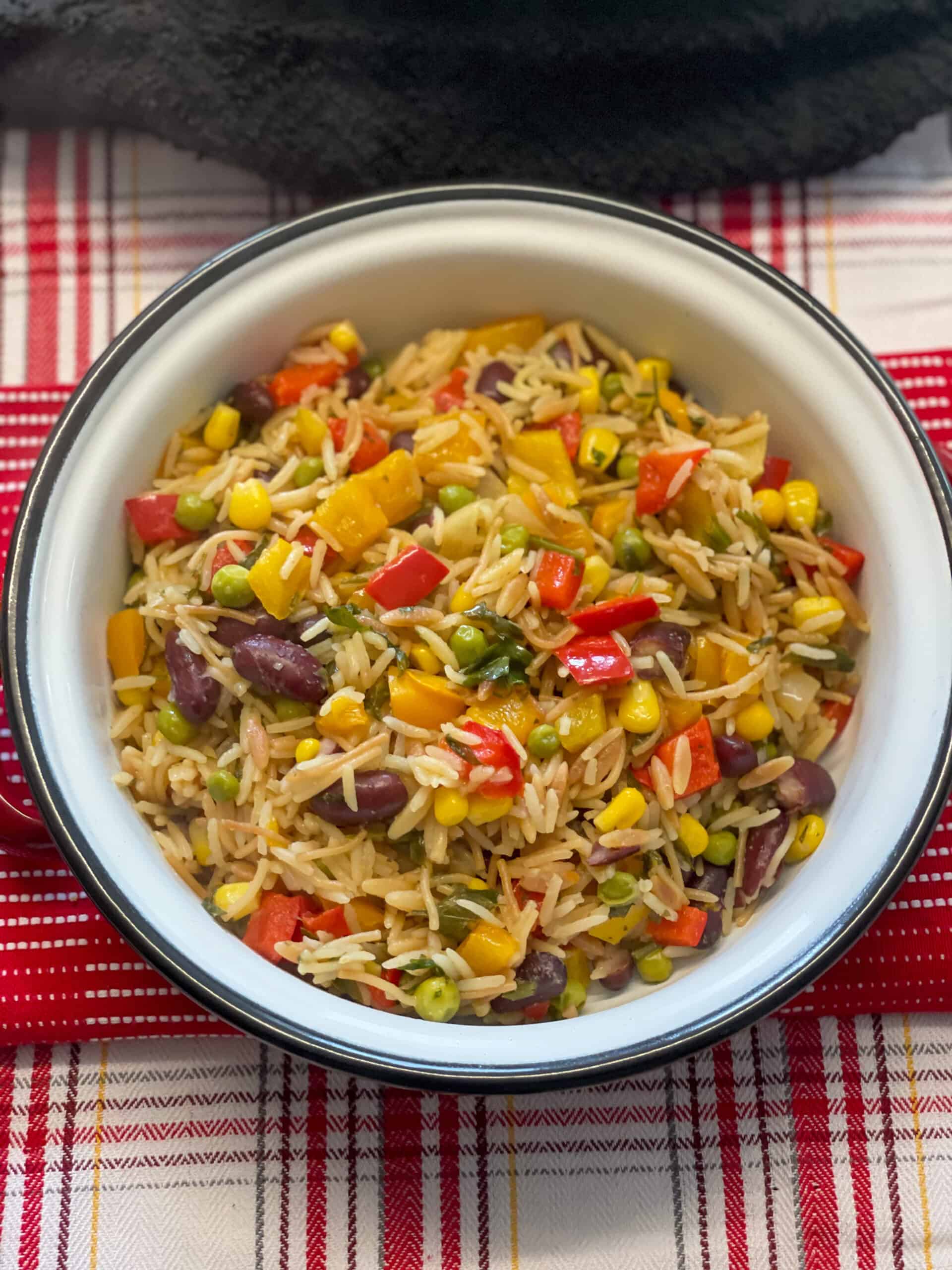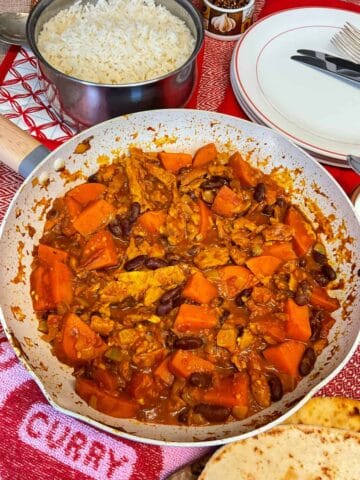This Vegetable, Bean and Pea Pilaf is a British recipe that is perfect for a fresh spring family meal. It is packed with wholesome green veggies and herbs - broad beans, peas, courgettes [zucchini], bell peppers, mint. thyme, parsley, and perhaps some chives or spring onions- and it can be quickly prepared in one pan. Of course, you can switch out any of the vegetables or herbs for any veggies or herbs you like as a pilaf is a very useful budget-friendly dish that is great for using up any seasonal veggies that you have to hand.

Pair up your pilaf with some crusty bread for extra carby comfort or a fresh crisp salad for even more wholesome green goodness. We use long-grain rice as it cooks quickly but you can replace it with a brown or whole-grain rice although you will have to adjust the cooking times and perhaps add extra liquid. Also this pilaf can be a no-oil pilaf if the margarine or oil is replaced with a little vegetable stock.
Jump to:
What vegetables are in season in spring?
The vegetables we use for our pilaf recipe are bell peppers, courgette [zucchini], broad beans, and peas, but these can be easily replaced with seasonal vegetables depending on the time of year.
For the spring months in the Northern hemisphere the vegetables in season include - asparagus, spring greens [a type of young cabbage similar to collard greens], spinach, early carrots, spring onions [green onions, purple sprouting broccoli, onions, savoy cabbage, cauliflower, kale, leeks, and lettuce.
Origin of pea and bean meals
Our pilaf recipe makes good use of budget-friendly peas and beans. Pea and bean meals have been sustaining people for hundreds if not thousands of years as they compliment each other beautifully.
Broad beans, also known as fava beans, have been part of the British diet since the medieval times, but have been around for much longer, as they have been cultivated for thousands of years in various parts of the world.
Other historic names for broad beans include Celtic beans, horse beans, field beans, and tic beans. Broad beans thrive well in cold environments so can be successfully grown over the winter periods, and they also dry well so perfect for long-term storage.

Likewise, peas are also a British favourite featuring in many old recipes throughout the centuries and have been sustaining people for thousands of years. One of the first British recorded cookbooks dated 1390 The Forme Of Cury has a few pea recipes including pea puree and German style peas.
During the medieval ages British peasants commonly cooked staple dishes of peas and beans as they were easy to obtain, relatively inexpensive, and provided lots of protein and valuable nutrition. As meat was so expensive it was rarely eaten by peasants, who were the ordinary working folk, and so peas and beans were indispensable alternatives.
Popular medieval dishes were pease pottage which is very similar to our British Mushy Peas recipe and our Old-Fashioned Pea Soup and pottage stew meals. During the medieval era anything that was cooked in a pot was classed as a pottage. Do have a look at our Medieval Inspired Potage Stew which is a fun stew devised by our history loving daughter when she was a teenager!

Peas and beans are two of the best veggie foods for vegan, vegetarian, and plant-based diets. Although arguably these valuable legumes are the perfect food for anyone, on any diet, except of course those who have allergies or intolerances.
More vegan recipes featuring tasty peas
Being a Scottish family peas are a budget-friendly staple food so we love finding new traditional recipes that highlight just how versatile and delicious peas can be.
Origin of Pilaf
A pilaf is a tasty rice dish cooked in stock or broth and often includes onions, herbs, spices, vegetables, beans, fish or meat. The rice and ingredients are usually sautéed in butter or oil before adding the liquid, which helps the rice become fluffy and keeps the grains separate. Once you know how to prepare a basic pilaf the recipe can be easily adapted with different ingredients and flavours.
Pilaf, also known as pilau or pilau, has been around for centuries and different variations are found in different cultures. The earliest references to dishes resembling pilaf date back to the ancient Persian Empire, now known as modern-day Iran, where rice was cultivated and became a staple in their Persian cooking. The Persians mastered the art of cooking rice in a variety of ways, including the pilaf method.
From Persia, the concept of pilaf spread along trade routes to Central Asia, the Middle East, East Africa, and the Indian subcontinent. Each region adapted the dish to include local ingredients and cooking traditions.
As the pilaf recipe traveled around, it took on various forms and names. For example, in India, it became known as pulao or biryani, and incorporated local spices. In the Ottoman Empire, it evolved into different regional variations of pilav.
Today, pilaf is a global dish, with each culture having its unique version, from the Spanish paella to the Caribbean rice and beans. The basic technique of cooking rice in a fat before cooking in a seasoned broth has remained a traditional method although there are now oil-free and fat-free versions of pilaf style dishes.

Ingredients
The ingredients you will need for this pilaf recipe is long-grain rice, broad beans, frozen or fresh peas, frozen broad beans [lima beans], courgette [zucchini], bell pepper, onion, garlic, fresh mint, fresh parsley, thyme sprig, bay leaf, salt & pepper, and vegetable stock.
Do have a look at our recipe FAQ'S section below for substitutions and ideas for switching up the flavours.
How to prepare
Our pilaf recipe is versatile and easy to adapt as you can substitute any of the vegetables with those you have on hand, need to use up, or simply prefer. Reduced-price veggies, old veggies lingering in the refrigerator, or even your own home-grown produce during a spring or summer bounty are all great choices. Just dice the vegetables into small, even pieces to ensure they cook evenly.
Additionally, if you're not a fan of fresh or frozen broad beans (fava beans), feel free to replace them with any type of cooked beans, or perhaps go with fresh or frozen edamame beans.
For the rice, you can swap the long-grain variety for whole-grain or brown rice, however, you'll need to follow the cooking instructions on the package for the best results and keep an eye on the liquid levels, as more may be required.


Step 1: Melt the margarine, or heat the oil, or instead heat ½ cup of vegetable stock if a no-oil pilaf is required. Add the onion, garlic, bell pepper, courgette, and broad beans, and cook for 8 minutes, stirring frequently.
Step 2: Next stir through the fresh parsley, mint leaves, and bay leaf.


Step 3: Add the rice and peas, and season with salt and black pepper.
Step 4: Stir and cook for 2 minutes.


Step 5: Pour in the hot vegetable stock, stir, and bring to a gentle boil.
Step 6: Cook over a medium heat for 5 minutes.
Step 7: Next place a lid over the pan and cook for 10 minutes.
Step 8: Turn off the heat but leave the covered pan on the cooker for a further 10 minutes as it will continue to cook using the residual heat.


Step 9: Remove the lid and test the rice for doneness. The rice should be cooked but if not pop the lid over and leave for a further 5 minutes.
Step 10: Fluff up the rice with a fork, and check the seasoning. Add extra salt and pepper to taste if necessary.

Step 11: Serve the pea and broad bean pilaf with extra fresh herbs - a few chopped chives or spring [green] onions are a nice addition. A dollop of plant-based mayonnaise or sour cream is also very tasty.
Recipe Notes
Storing
Chill cooked rice quickly [within an hour if possible], and place in the refrigerator within a covered container, for 1-2 days although cooked and chilled rice is best eaten quickly so plan to use it the next day if possible or freeze it soon after it has cooled.
Freezing
Freeze cooled rice by adding it to a freezer and food safe container or food bag, and storing for 2-3 months. Frozen rice can be used from frozen as it will quickly defrost as it is reheated.
Reheating
As cooked rice can develop harmful spores if not quickly cooled and chilled, it is very important to reheat rice to an internal temperature of 75C [165F]. A simple food thermometer is an inexpensive and a really good purchase for peace of mind. Alternatively, when reheating rice without a food thermometer make sure that it is piping hot throughout.
To reheat rice pilaf you can use a microwave or a non-stick pan such as a wok or deep frying pan, or a skillet. Often adding a little water or vegetable broth/stock can help reheat the rice and prevent sticking to the pan. Stir the rice often over a medium-high heat to ensure even reheating.
For useful information and guidance on storing and reheating rice refer to this article over on Gov.UK and for further information have a look at this article from University of Wisconsin-Madison which has advice on the safe handling of cooked rice.
FAQ'S
Yes, rice, peas, beans, and vegetables are fine for gluten-free diets as they are naturally gluten-free. Although do check that any stock, broth, margarine, seasonings, spices, and additional ingredients that you add to your pilaf are also free from gluten ingredients.
Yes, we have a few substitution ideas:
* You can replace any of the vegetables for those that you prefer, or any any vegetable you have to hand and needs using up, reduced or special buy vegetables, home-grown vegetables, seasonal vegetables, etc.
* Frozen mixed vegetables are ideal for pilaf although do use the same amount of vegetables as specified within the recipe. Also ensure that the vegetables are in even-sized pieces so that they cook evenly.
* You can switch out some or all of the fresh vegetables for tinned or canned vegetables.
*This recipe uses frozen broad beans but fresh broad beans or similar, such as frozen or fresh edamame [soya] beans could be used instead. Alternatively replace the fresh or frozen beans with cooked beans.
* You can switch out any of the fresh herbs and use those that you like best. Additionally, you can use dried herbs instead, and add extra flavours in the form of your favourite spices and seasonings.
* The long-grain rice can be replaced with basmati, or whole-grain or brown rice varieties but do keep in mind that brown rice tends to require a longer cooking time so the pilaf will require additional cooking. Also, you will likely need to add extra liquid before and perhaps during cooking to prevent the rice from sticking. Consult your rice package instructions for guidance.
* Instead of fresh onion and garlic you can use the dried varieties - about a few heaped teaspoons of dried garlic and dried onion. This is a great way for adding a quick flavour boost.
You can add any spices, herbs, seasonings or flavours that you like to the pilaf as you can tailor it to your own flavour preferences.
We have used fresh herbs so that we can highlight the fresh vegetable flavours but ingredients such as garlic powder, onion powder, spices such as paprika, cayenne pepper, chilli pepper, cumin or coriander powder, dried herbs such as Italian mixed herbs, French style mixed herbs, dried basil, dried parsley, dried thyme, dried oregano, or spice mixes such as curry powder, fajita powder, Ras el Hanout, Harissa, Chinese 5 spice, Dukkha, etc.
Examples of extra flavours are soy sauce, white wine vinegar, apple cider vinegar, white miso paste, nutritional yeast flakes, mustard powder, etc. Experiment and add your favourite seasonings.
Yes, rinsing the rice under running fresh water washes away excess starch from the surface of the rice grains. This helps prevent the rice from becoming too sticky or clumpy when cooked, and ensures that the rice grains remain separate and fluffy.
Rinsing the rice also helps to clean the rice, removing any dust, dirt, small stones or grit, or impurities that might be on the grains.
It's easy to rinse the rice as the rice can be placed into a sieve and then rinsed under the cold water tap until the water runs clear, and then it’s ready to be used in your recipe.
You can use basmati rice, brown rice or whole-grain rice, jasmine rice, wild rice [which is actually a grass seed rather than a rice], or Arborio rice which is the type of rice generally used for risottos. However, do consult the rice packaging for specific preparation instructions as they may take longer to cook and require extra liquid. Also a different rice will result in the pilaf having a different texture and flavour such as if you use a brown or whole-grain rice the pilaf will be more chewier in texture, with a nutty and earthy flavour.

More budget-friendly vegetable, rice and bean recipes
Recipes that are prepared with vegetables, beans and rice are budget-friendly, wholesome, and delicious. They are also really easy to prepare and very forgiving as you can add less of one ingredient and more of another ingredient, switch out a herb or spice for those you like better, and easily double or half the quantities for more or less portions to suit your family.
The slow cooker adds an extra level of connivence as you can add the ingredients and go about your day so no need to watch the stove at least for a few hours at least!
Our favourite rice and beans recipe to prepare in the slow cooker is this Slow Cooker Rice and Peas which can be the main dish, a side-dish, or quickly cooled and chilled and then used as a filling for a Burrito.
For a tasty brunch or lunch this Vegan Smoked Tofu Kedgeree is especially nice especially for a special brunch such as Mother's Day, Father's Day, Easter or Boxing Day.
And for midweek family meals you can't get better than this Mexican Rice and Bean Casserole which has a fun cheesy nacho topping. Another fun tasty meal is this Rice-A-Roni prepared with kidney beans, sweetcorn, peas and bell peppers.
***please note: for US measurements click the 'US customary button' within the recipe and the measurements will switch to tablespoons, cups, and ounces.***
📖 Recipe

Vegetable, Pea and Bean Pilaf
Equipment
- Large non-stick pan or skillet or a wok, with lid
Ingredients
Pilaf:
- 1 tablespoon margarine or oil [or replace with ½ cup [125ml] of veggie stock/broth, adding extra as necessary]
- 1 medium onion [diced, about 125 grams prepared]
- 4 garlic cloves [fine diced]
- 1 large courgette [zucchini] [diced, about 200 grams after courgette prepared]
- 1 bell pepper [diced, any colour]
- 150 grams broad beans [lima beans] [fresh or frozen]
- 225 grams long grain rice [rinsed under fresh running water and then drained]
- 225 grams peas [fresh or frozen]
- 1 bay leaf
- 15 grams fresh mint [or 2 teaspoons dried mint]
- 15 grams fresh parsley [or 2 teaspoon dried parsley]
- 1 sprig fresh thyme [or 2 teaspoons of dried thyme]
- 600 millilitres vegetable stock [hot, using hot stock just means the pilaf will be cooked quicker]
Garnish, optional
- extra fresh mint, parsley, and add chopped chives if liked or sliced spring onions [green onions]
Instructions
- Melt the margarine or heat the oil, or if prepare an oil-free pilaf bring to a gentle boil ½ cup vegetable stock.1 tablespoon margarine or oil
- Add the onions, garlic, pepper, courgette, bell pepper and broad beans. Over a medium heat cook for 8 minutes, stirring frequently to prevent sticking.[If using vegetable stock instead of oil then you can place a lid over the pan but do stir frequently and add small amounts of extra stock if necessary to prevent sticking to the pan]1 medium onion, 4 garlic cloves, 1 large courgette [zucchini], 1 bell pepper, 150 grams broad beans [lima beans]
- Next, add the rice and peas and cook for 2 minutes, stirring frequently.225 grams long grain rice, 225 grams peas
- Add the bay leaf and the fresh herbs. Stir through ¾ teaspoon of salt and a good grinding of black pepper.1 bay leaf, 15 grams fresh mint, 15 grams fresh parsley, 1 sprig fresh thyme
- Give it all a good mix and pour in the hot vegetable stock.600 millilitres vegetable stock
- Bring to the boil, add a lid over the pan, and turn the heat to low. Cook for 10 minutes.
- Turn the heat off the cooker ring but leave the pan on the cooker stove top for a further 10 minutes and it will continue to cook within the residual heat. Don't remove the pan lid.
- The liquid should be soaked up and the rice cooked but if not just pop the lid back on and leave for an extra few minutes until the rice is soft. [If you think that the rice needs a few minutes extra cooking and the liquid has been soaked up just add about a half cup of boiling water or vegetable stock stir it through and add the lid. Cook for a further 5-10 minutes over a medium heat, and check to see if it's soft.]
- Once cooked give the rice a good stir and fluff up with a fork. Remove the bay leaf and thyme sprig.
- Check the seasoning and add extra salt and pepper to taste.
- Scatter over extra fresh herbs if liked. Chopped chives are a particularity tasty garnish, as are a few sliced spring onions [green onions]. We like to add a small dollop of plant-based mayonnaise or Oatley creme fraiche once served onto plates.Enjoy with a wedge of crusty bread such as French baguette and/or a nice fresh salad.extra fresh mint, parsley, and add chopped chives if liked or sliced spring onions [green onions]
Notes
- Nutritional information is provided for guidance only and is not a strict calculation as ingredients vary.
- Leftovers should be placed in the refrigerator as soon as they have cooled [preferably within an hour], and can be kept for a few days or freeze for 2-3 months.
- Reheat the pilaf in the microwave until piping hot throughout and steaming. Or within a non-stick pan and reheat over a medium-high heat, stirring frequently, until piping hot and steaming throughout. A little extra water or stock can be used to prevent sticking.
- Any of the vegetables can be replaced with your choice of vegetable, although do dice each veggie to similar small sizes. Frozen mixed veggies or canned veggies can be used if preferred.
- We used long-grain rice which cooks quickly but you can use any type of rice as long as you take into consideration that different types of rice may take longer to cook than stated on our recipe and may also require extra liquid.
- You can add more fresh herbs to this recipe, add different herbs, use dried herbs, add spices including spice mixes such as curry powder or chilli powder, add fresh chilli, switch out the beans & veggies, etc. Do have fun with different flavours and ingredients and make the recipe your own!
- For more recipe notes and FAQ's do have a look at our recipe notes and FAQ section above this recipe.
Nutrition
Prepared our Vegetable, Bean and Pea Pilaf? We would love to know how you got on with the recipe and whether you added extra flavours or adapted the recipe. Drop us a comment below and click the star ratings. Thanks so much, love Jacq x














Leave a Reply